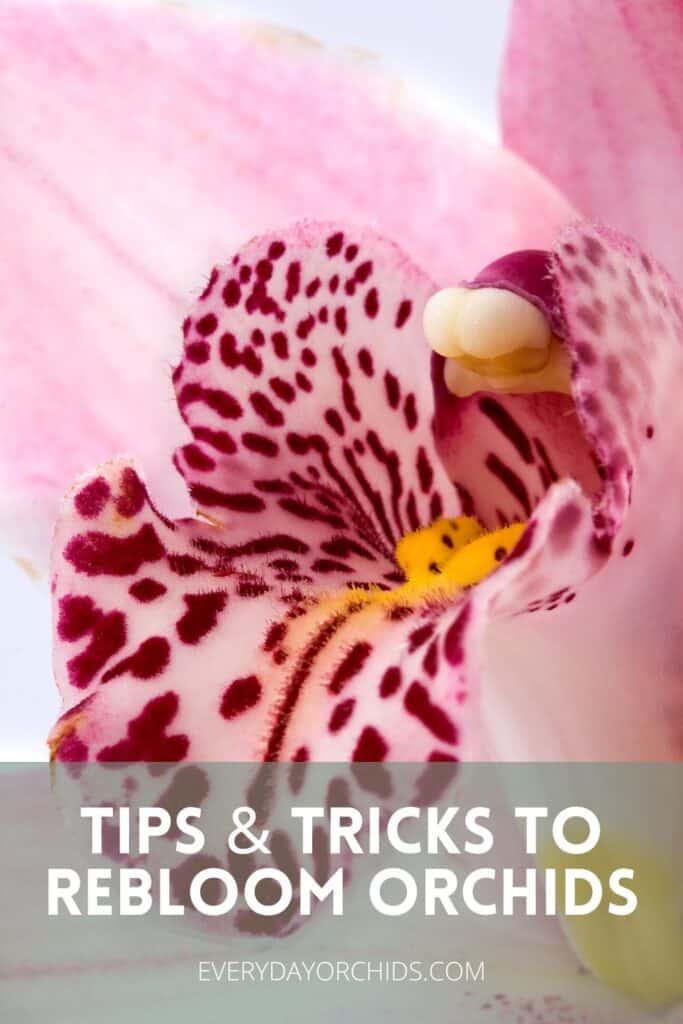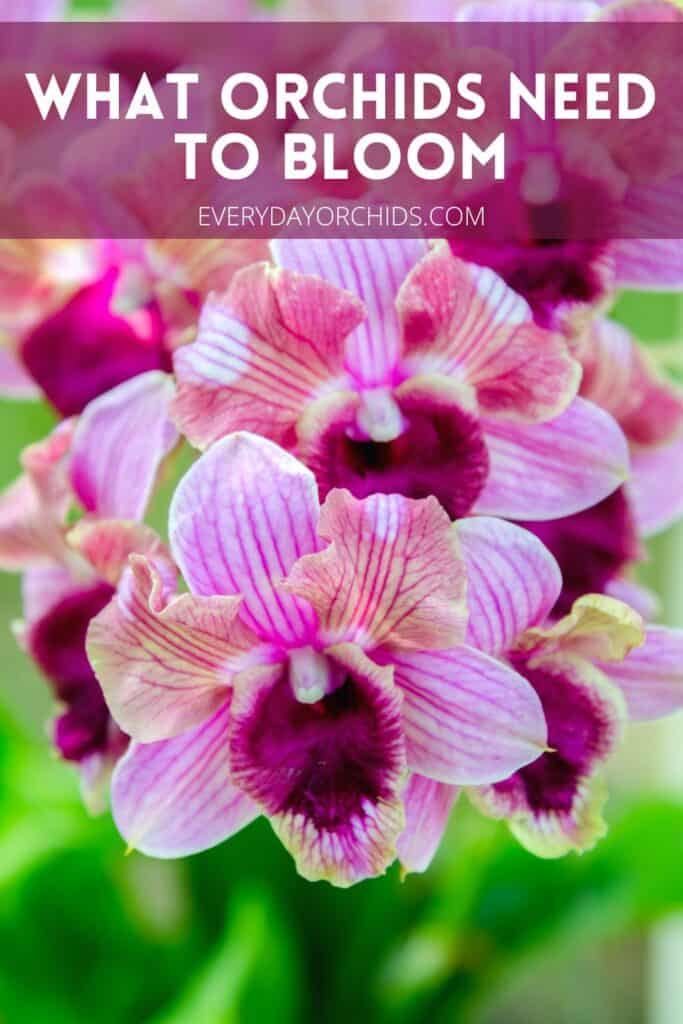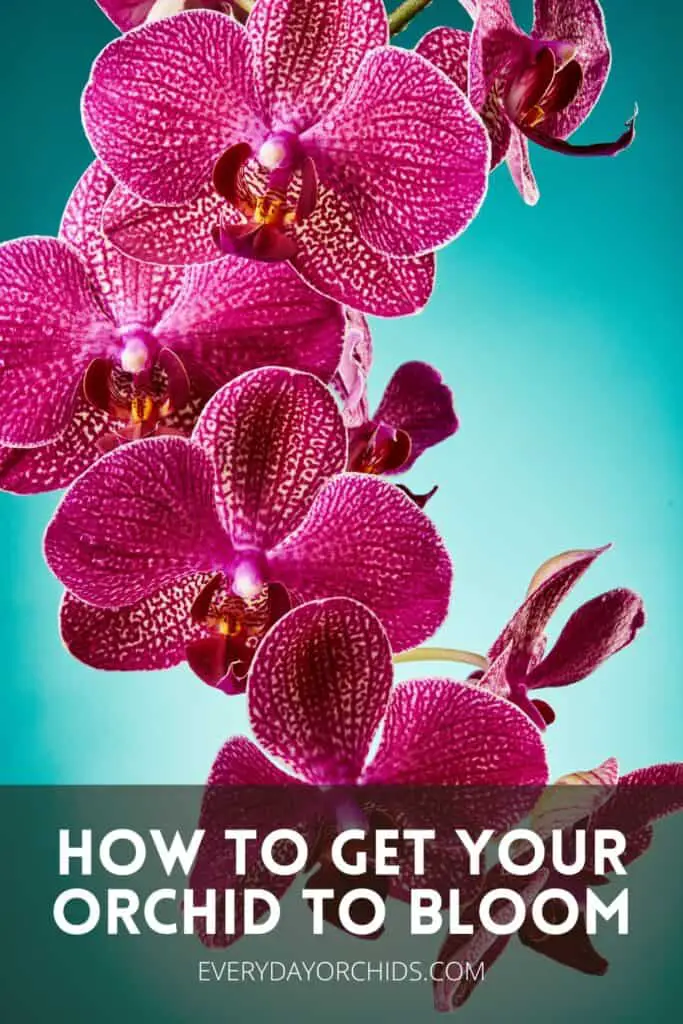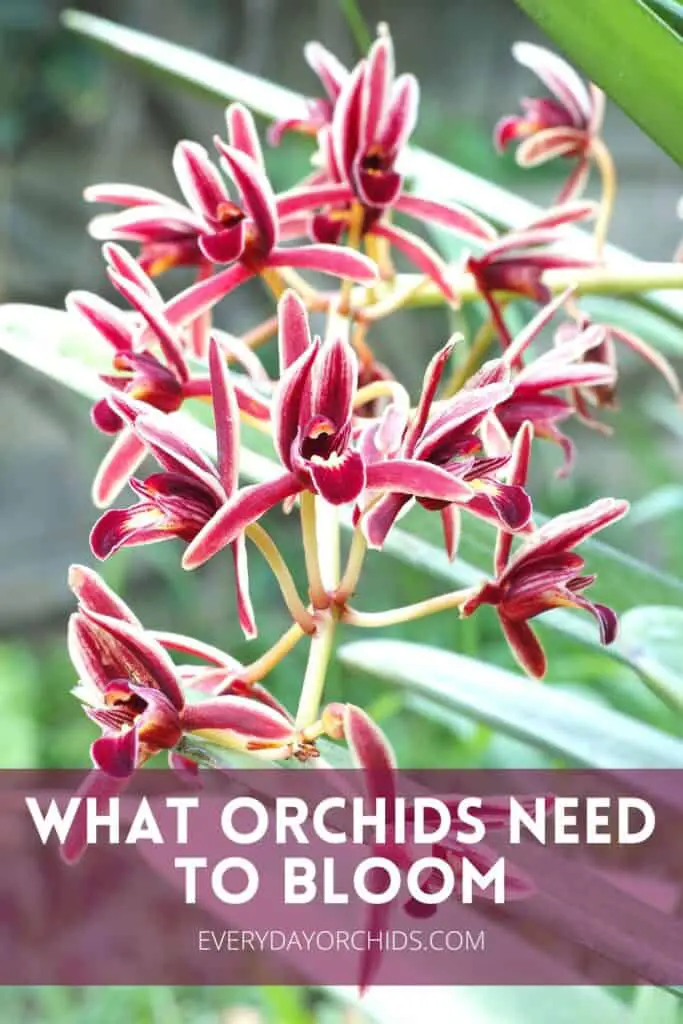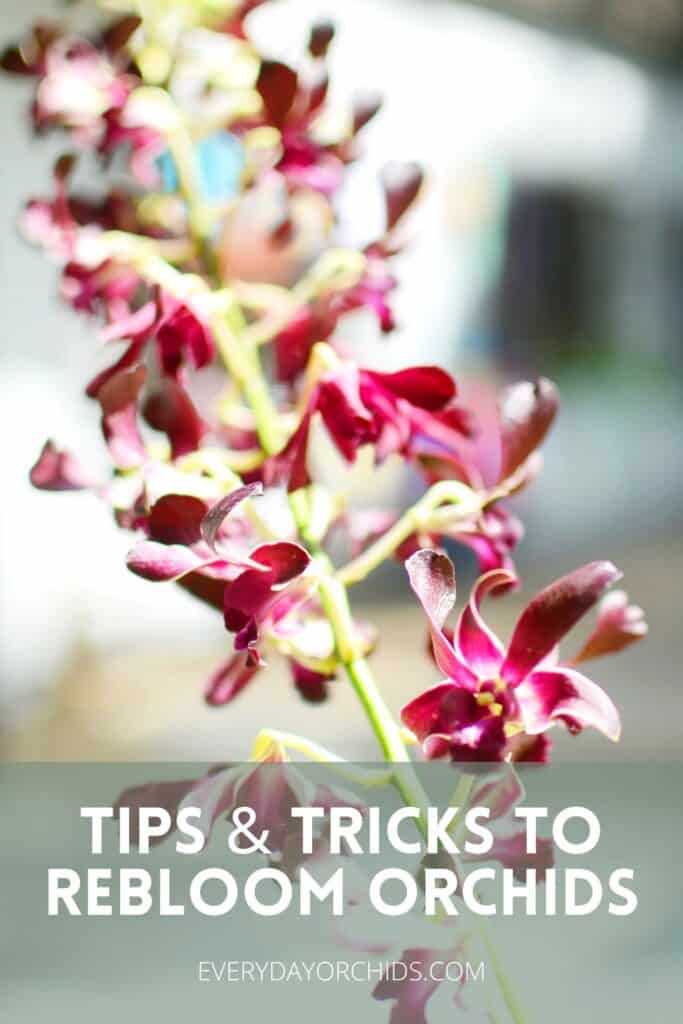If you are new to orchids, you may be wondering about orchids and their blooms. Specifically, you may wonder how often orchids bloom, when they bloom, and what an orchid might need in order to bloom and rebloom.
In general, most healthy orchids bloom just once a year, but this will vary according to species. Also, depending on the orchid species, an orchid will stay in bloom anywhere from a week to several months.
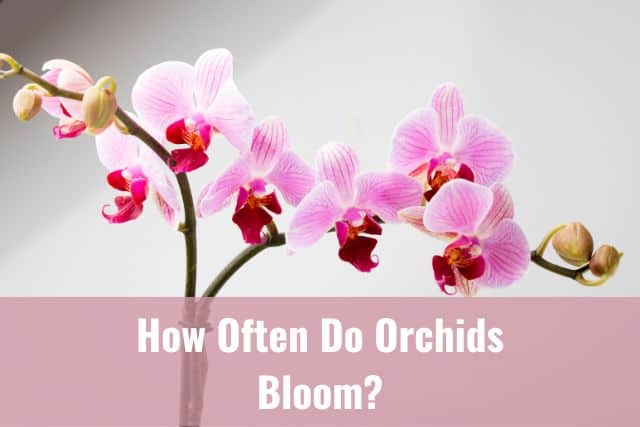
Orchids are unlike many other plants. When their flowers are in bloom, they stay blooming for weeks at a time. However, when those flowers fall off, new orchid growers may be wondering what to do with an orchid after it has lost its flowers. What happens next? Will your orchid bloom again and when?
In this article, I’ll go over how often orchids bloom in more detail, including when an orchid’s blooming season occurs. I’ll also answer top questions about how often orchids bloom indoors and how to to increase your orchid’s chances of reblooming. Keep reading to learn more.
Please note that these links are affiliate links and as an Amazon Associate, I earn from qualifying purchases. Purchases made through affiliate links in this post may generate commissions at no additional cost to you. Use this link for a discounted Amazon Prime trial. Thank you for your support!
Table of Contents
How Often Do Orchids Bloom Indoors?
This may come as a surprise to you, but indoor orchids bloom at the same frequency as outdoor orchids. With proper care, you can expect a healthy orchid will bloom once a year. Happy, healthy orchids may bloom twice a year on their own, but this is not common and you should not expect this.
Blooming frequency will also vary according to species. Phalaenospsis orchids, one of the most popular orchids sold today, usually bloom just once a year, whether they are indoors or outdoors. Cymbidium orchids also bloom just once a year. Vanda orchids, on the other hand, may bloom 2-3 times per year.
Of note, younger orchid plants tend to produce less flowers than an older, more established orchid. The flowers blooming on a younger orchid will also be smaller. This is because younger orchid plants tend to be smaller as a whole. As you may imagine, older orchid plants are also generally larger in size.
When Do Orchids Bloom?
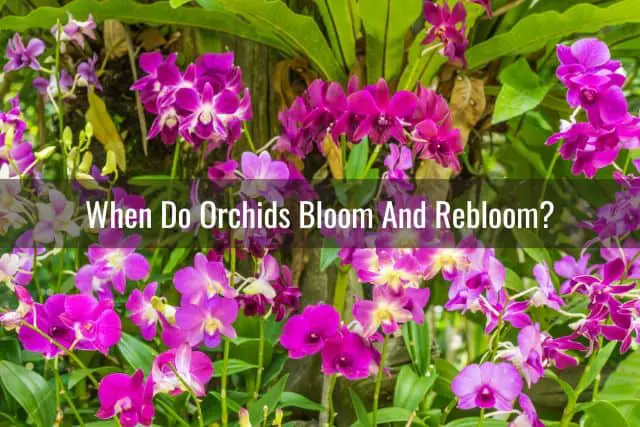
Blooming season for most orchids typically occurs in the late winter and early spring months. Here in the United States, this would be late January to early April.
However, this is not a hard and fast rule. While most orchids will naturally bloom during late winter or early spring, they can also be forced to bloom “out of season.”
How Do Orchids Bloom “Out Of Season”?
First, let’s define what it means to bloom “out of season.” An orchid’s natural blooming cycle normally occurs in the late winter or early spring. This is when you would expect orchid flowers to appear if an orchid were growing out in its native habitat in the wild.
An orchid that blooms “out of season” is one that flowers any other time of the year outside of the natural blooming period.
For example, you can often find Phalaenopsis orchids for sale in stores year-round. These orchids are always sold with flowers in bloom no matter what time of year it is. These are orchids that are blooming “out of season.”
The question is, how do orchid growers manage to always have orchids in bloom, year-round? Well, orchid growers can force orchids into bloom by manipulating the temperature in the orchid’s growing area.
First, by dropping temperatures at night and creating a 20-degree difference between night and day temps, the orchid is triggered into developing an orchid flower spike.
Then, once the flower spike has grown and set, growers raise the temperature in the orchid’s growing area. This tricks the orchid into thinking spring has come. The orchid’s flower buds start to open and it begins to bloom. This is why you are able to find orchids in bloom all year-round.
Will My Orchid Continue To Bloom Out Of Season?
In most cases, yes, your orchid will continue to bloom “out of season.” When you purchase a blooming orchid outside of the usual blooming season, that orchid tends to adapt to this new “schedule” and stays with it.
For example, I have bought orchids in bloom during the summer or fall. These orchids have rebloomed around the same time each year (summer or fall) and not during the typical blooming season.
This is actually a great tip if you need an orchid to be in bloom during a particular time of year, like for an annual celebration such as Lunar New Year. You can simply purchase orchids in bloom during that time. Chances are, it will rebloom on this “off-season” schedule each year.
However, be aware that there is also a chance that the orchid will adjust and revert back to it’s natural blooming cycle. In many cases, you won’t be able to predict what your orchid will do based on just one blooming season. You’ll just need to wait and see what your orchid does the following year.
How Long Do Orchid Flowers Last?

This is a tricky question and the answer really varies depending on the orchid species. How long orchid flowers last varies depending on the orchid species and the general health of the orchid. You can find a list with blooming periods of the most popular orchid species here.
Phalaenopsis orchids, for example, will bloom for months at a time. I’ve had Phalaenopsis blooms remain on the plant for up to 3 months (12 weeks!) before they started to wilt and fall off.
Obviously, orchid blooms left on the plant will last longer than cut orchid flowers. However, there are things you can do to cut orchid flowers to help them last longer, such as keeping them out of direct sunlight. You can also use a tall vase to support the thin, long orchid stems.
Read more about how to make cut orchids last longer here.
How Do You Care For An Orchid After The Flowers Fall Off?

Once those orchid flowers fall off, you may be wondering if, and when, your orchid will bloom again.
To answer that, yes, with the right care, your orchid WILL bloom again. Follow this guide for orchid care after flowering to learn how to care for your orchid once it has lost its blooms.
People totally new to orchids may mistakenly think the orchid is dead after the flowers fall off. They may even throw it away. Don’t do this! The orchid is not dead yet. Rather, it is simply entering into the next stage of life.
This stage is one of growth, where the focus is on developing more roots and leaves. After this growth phase, the orchid then transitions into a dormant phase during the cooler fall and winter months.
To learn more, read about the phases of orchid growth and dormancy here, so you know what to expect.
Tips For Getting Your Orchid To Bloom Again
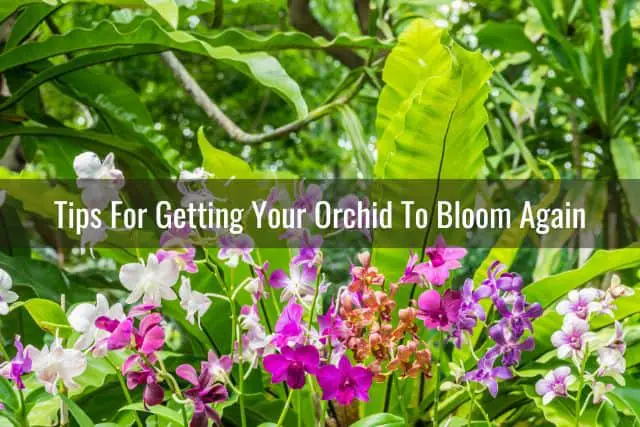
There are several key components necessary in order to get your orchid to bloom again. These include good lighting, adequate moisture (watering and humidity), a temperature difference between night and day, and proper fertilization.
The exception to this is when you repot your orchid. Even if you provide your orchid with all these things, repotting your orchid will decrease the chances it will bloom again the next year. In many cases, this is normal and unavoidable.
This is because repotting, and all that it involves, can be highly stressful for a plant. Oftentimes, you are pruning off the dead roots, changing the potting media and the orchid pot. An orchid needs time to recover after such a massive transition.
So, instead of blooming, your orchid may take some time to focus on root and leaf growth and building up its reserves. It may skip blooming the following year, and this is to be expected.
With continued proper care, your orchid will likely bloom again after it has had some time to rest, recover and rebuild its energy reserves.
If you are trying to rebloom your orchid, here are a few things you can do to increase your orchid’s chances of flower production.
In particular, you’ll want to pay close attention to lighting, fertilization, temperature and moisture levels in the months leading up to the blooming season.
Lighting
First, make sure your orchid has lots of light. This is probably the most important factor in getting orchids to rebloom, in my opinion.
In general, an average of 12 to 14 hours of bright, indirect light each day is ideal.
Light provides energy to the plant. The orchid harvests and collects energy through its leaves. It will then convert that energy into usable sugar and nutrients.
The more hours of high quality light exposure, the more the orchid is able to collect and store energy for activities such as root and leaf growth and bloom production.
If you aren’t sure how to tell what kind of light your home has or how much light your orchid needs, then please read this Everyday Orchids guide to orchids and light to learn more.
Artificial Lighting
One of the problems that orchid growers run into is inadequate lighting.
This may be due to the home not having a lot of natural light, or due to the changing of the seasons.
The winter months leading up to the spring blooming season are typically the darker months, where there are less hours of light in the day. Even when there is natural daylight, it may be not be very bright, due to overcast conditions, rain or general weather conditions.
If you notice that your home doesn’t get good natural lighting to begin with, this may be a problem, especially when you factor in the shorter days and less hours of light.
To address this issue, invest in artificial lighting for your orchids. There is a wide variety of lighting options available in hardware stores and online.
I recommend choosing a full-spectrum LED light for your orchids. Use a timer to avoid having the light on 24 hours a day. Your orchid still needs day and night cues to trigger bud formation. Artificial lights should be on no more than 12-15 hours per day, depending on the season.
You can read more about how to set up artificial lighting for orchids here, along with recommendations for different types of lights.
Fertilizer
The right kind of fertilizer is also key to getting your orchid to rebloom. In the fall and winter months, fertilize your orchid with a bloom booster orchid fertilizer.
Bloom booster orchid fertilizer is different than regular orchid fertilizer, in that it has higher phosphorus levels. Phosphorus is essential for bloom production. Having more of it in the fertilizer gives orchids that jump start that they need for flower development.
I recommend using something like SunBulb’s 11-35-15 Bloom Booster fertilizer for orchids. If you prefer to feed your orchids with a mist spray, then The Grow Co’s fertilizer mist spray for orchids is another good choice.
Feed your orchids using a bloom booster fertilizer starting a few months before the blooming season for best results. This is usually done during the fall as part of your fall orchid care checklist.
Temperature
Remember how orchid growers are able to force orchids into bloom by manipulating temperature levels? Well, differences in day and night temperatures are essential for triggering orchid bloom production.
Generally, temperatures start to cool down during the fall months. This drop in temperatures signals a changing of the seasons to orchids.
A 20-degree Fahrenheit temperature difference between night and daytime highs is needed to trigger flower production in orchids.
In other words, if you are having a hard time getting your orchids to rebloom each year, check the temperature highs and lows in your orchid’s growing area. Make sure that your orchid has a 20-degree drop in temperature at night from the daytime highs. You can accomplish this by opening a window in the room in the evenings.
I use a simple hygrometer in my orchid’s growing area to keep track of the temperature throughout the day. I love this one by ThermoPro. It lets me see at a glance what the current temperature is, along with the 24-hour temperature highs and lows and humidity levels in my orchid’s growing area.
Watering And Humidity
Lastly, make sure you are providing your orchid with regular watering and keeping humidity levels within the orchid’s preferred range. This is not only important for flower production but also helps maintain the overall health of the orchid.
If the orchid is too dry due to low humidity or infrequent watering, it will not produce flowers. The orchid will ration the moisture and water it does have and give it to the leaves and roots, rather than the flowers. As a result, the flower buds may start to shrivel and fall off early without ever fully opening.
To prevent this from happening, check your orchid’s potting media regularly. Water your orchid when the potting media is nearly dry.
Also, keep the humidity levels around your orchid within its preferred range. Each orchid species will have a preferred humidity level, so you’ll want to first research your orchid species and find out its exact care needs.
For example, Phalaenopsis orchids generally like humidity levels around 50% but can tolerate slightly higher or lower levels. In contrast, Miltoniopsis orchids require high humidity levels, between 50-70%, in order to stay healthy. Low humidity levels can result in pleated leaves, lack of bloom production and dried, shriveled roots.
Fortunately, proper watering and keeping the humidity levels within the right range will help your orchid bloom again the following year.
Final Thoughts
The majority of orchids bloom just once a year, with a few species blooming two or more times a year. However, even though most orchids bloom just once a year, their flowers can last a long time.
Follow these simple tips and tricks outlined here, on Everyday Orchids, to help your orchid stay healthy and rebloom year after year.
With the right care, your orchid will continue to grow and you’ll be rewarded with a gorgeous display of flowers each blooming season.
